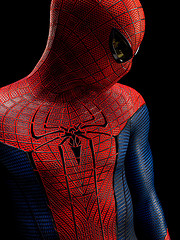Here’s the thing: I’m a purist when it comes to my superheroes. It’s one thing to radically evolve a hero that originated in a film franchise…I sort of figure that anything’s fair game, there. When you’re adapting a hero from a literary history to the screen, however (yes, I count comic books as literature), then I think that remaining largely true to at least the essence of the book, as well as to most of its specifics, is paramount. In other words, I consider the books to be canonical.
So, when a director can take some liberties with a general story arc, weaving it in such a manner from beginning to end that it remains completely true to the original character while viewing him through the lens of a daringly original story arc over the course of three films, in such a way that I’m perfectly willing to accept the trilogy of films as canonical in it’s own right…that’s quite an accomplishment.
And that is something that Christopher Nolan has done in all three of his films, The Dark Knight Rises being no exception. And, by the way, I’m giving some spoilers here.
This third film in the franchise continues Nolan’s exploration of a hero that, let’s face it, isn’t psychologically healthy. Throughout his comic book history, the Batman has walked the thin line between hero and anti-hero. While ultimately choosing the self-sacrificial path of the hero, he uses methods that are questionable and that flirt with vigilantism. Yet, he is a character of rigid ethics, and has set lines across which he will not step…although he occasionally comes pretty close. This is the second consecutive film in which he has encountered a villain that brings him to that edge, and we hear this overtly in this film (when Batman returns Bane’s line, “then you’ll have my permission to die”). Batman isn’t willing to kill his opponent, but isn’t taking the extra effort to prevent his demise, like we saw him do with the Joker.
For anyone who followed the Knightfall story arc from circa 1993, the scene in which Bane “breaks” Batman is nearly picture-perfect from the comic book frame. This event follows a series of poor choices, as Bruce Wayne adopts the Batman persona again after several years of being a recluse (following his taking the blame for Harvey Dent’s death), and after ignoring the advice of Alfred, who encourages him that the city needs Bruce Wayne’s knowledge and resources, not Batman’s vigilantism.
If one were to attempt to pinpoint a theme for this film, I would say that it is lies, and that, however noble the intention in which they are told, they always return with a destructive force. Batman’s and Commissioner Gordon’s lies about Harvey Dent come back in a destructive way to the entire city when Bane forces them into the light. Alfred’s lie about Rachel’s choosing Bruce tears he and Bruce apart (with a poignant and beautifully-acted scene in which Alfred recounts his love for Bruce since he first heard his cries “echo off these walls”). In fact, one could say that relying on a lie to protect one’s loved ones is not the choice consistent with the nature of a hero. Bruce’s answer, at least initially, is to continue his self-destructive path, a path of true heroism driven by the questionable motive of welcoming his end, in a way that proves a Pyrrhic victory for the city of Gotham in the end.
The acting throughout this film is incredible. I can’t actually recall a single performance that was less than excellent. Nolan has done a beautiful job rendering one of Batman’s most evil and imposing villains (Bane identifies himself as “the devil,” and as a “necessary evil”), arguably his most threatening arch-nemesis after the Joker. I wondered at Anne Hathaway being cast as Catwoman, but this is the first time I’ve seen Catwoman as her spunky self appear on the screen, both visually as well as deeply as a character. Catwoman is Batman’s mirror image, after all…a villain who walks the thin line of being a hero. This film does Catwoman justice, just as it does every other single major character that appears, with the possible exception of John Blake…and I’ll simply refer that to the aforementioned liberties taken with the mythology and let you decide on that.
As expected, the action sequences are breathtakingly real and well-paced, never overwhelming but completely absorbing. And, of course, Batman gets a new vehicle for this film because…well, because that’s just the way is has to be…and the film’s designers continue their realistic, paramilitary design work that sold me immediately from the first movie forward.
Ultimately, this movie about the Batman as a symbol, and the recurring through-line is that Batman as a symbol is much larger than Bruce Wayne, and that it must be for the good of the city which is what Bruce Wayne always places above his own good. Thus, anyone can be Batman, because it is Batman in which the city needs to believe. This concept is illumined by multiple characters throughout the movie, and, if you haven’t seen it yet, we’ll just say that it’s a great lead-in for another film (*cough* Nightwing *cough*).
This film is a thorough and psychologically intriguing view on Batman that pleases both long-time fans and those who haven’t been interested yet. At nearly three hours, it’s long, but I didn’t want it to end when those three hours were over. Even if you’re just interested in a summer blockbuster, this is worth your while…and I bet you love the character of the Batman as much as the rest of us do when it’s over.



